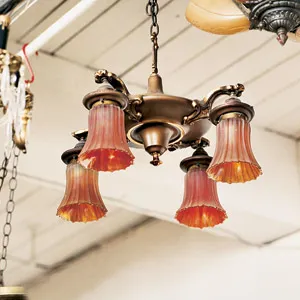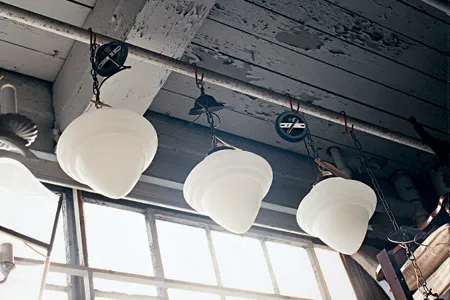
Vintage light fixtures can add character, charm, and a touch of history to any home. From elegant chandeliers to sleek Art Deco sconces, these timeless pieces offer a unique blend of form and function. In this guide, we explore the world of vintage lighting, including practical tips for selecting, installing, and maintaining these beautiful artifacts.
Types of Vintage Light Fixtures
Vintage light fixtures come in a wide variety of styles, each reflecting the design sensibilities of its era. Here are some of the most popular types you might encounter in your search for the perfect vintage piece.
Converted Gas Fixtures
Converted gas fixtures are among the most expensive vintage lights available today. These pieces often feature cast brass or bronze arms adorned with intricate floral, animal, or human forms. Hand-blown glass shades in vibrant colors add to their charm and value.
For example, an antique shop can sell a chandelier with ram’ s-head castings and frosted glass shades salvaged from a late-19th-century Second Empire–style mansion for upwards of $8,500.
Art Deco and Moderne Styles
The 1920s, ’30s, and ’40s saw a boom in mass-produced light fixtures. These fixtures were designed for the millions of new homes, schools, and commercial buildings being constructed with central electricity.
Art Deco and Moderne styles, popularized after the 1925 Paris Exposition Des Arts Decoratifs, remain particularly appealing to modern collectors. These clean-lined designs often feature geometric shapes, chrome accents, and frosted glass shades. Their timeless elegance allows them to complement both vintage and contemporary interiors.
Mid-Century Modern Designs
Mid-century modern lighting, popular from the 1940s to the 1960s, is characterized by its sleek lines, organic shapes, and innovative use of materials. Designers like George Nelson and Serge Mouille created iconic fixtures that are highly sought after today.
These fixtures often feature materials like teak, walnut, and brass combined with colorful glass or acrylic shades. Sputnik chandeliers, with their starburst designs, and globe pendant lights are classic examples of mid-century modern lighting that can add a retro-futuristic touch to any room.

How To Identify Authentic Vintage Fixtures
Distinguishing genuine vintage fixtures from modern reproductions requires a keen eye and some knowledge. Here are key factors to consider when assessing the authenticity of a vintage light fixture.
- Age Indicators: One of the most reliable ways to determine a fixture’s age is by examining its construction. Older fixtures often show signs of hand-craftsmanship, such as slight irregularities in metalwork or glass blowing. Look for patina on metal surfaces, which develops naturally over time and is difficult to replicate artificially.
- Brand Marks and Signatures: Many reputable lighting manufacturers marked their products with logos, stamps, or signatures. You can find these on the base of the fixture, inside the canopy, or on the sockets. Familiarize yourself with marks from well-known vintage brands like Lightolier, Pairpoint, and Tiffany Studios to help authenticate your finds.
- Materials and Craftsmanship: Vintage fixtures typically use materials that were common in their era. For example, early 20th-century fixtures often feature brass, bronze, or copper. The quality of craftsmanship is usually high, with attention to detail in decorative elements and joinery.
Assessing the Condition of Vintage Lights
Before purchasing a vintage light fixture, assess its condition thoroughly. This evaluation will help you determine whether the piece is safe to use and if any restoration work is needed.
- Glass and Shade Integrity: Inspect glass shades and other delicate components for chips, cracks, or missing pieces. While minor imperfections can add character, significant damage may affect the fixture’s functionality and value. For pendant lights, make sure that hanging mechanisms are secure and in good condition.
- Metal Finishes and Patina: Check metal surfaces for excessive corrosion, pitting, or flaking finishes. A natural patina can enhance a fixture’s appeal, but severe deterioration may require professional restoration. Be cautious of fixtures with heavily polished surfaces, as this might indicate recent refinishing that could diminish authenticity.
- Wiring and Electrical Components: Examine the wiring carefully. Vintage fixtures often need rewiring to meet modern safety standards. Look for signs of wear, fraying, or brittle insulation. Sockets should be intact and free from cracks or damage.
Safety Considerations for Vintage Lighting
While vintage light fixtures can be beautiful additions to your home, safety should always be your top priority. Here are some safety considerations to keep in mind when dealing with antique lighting.
- Electrical Inspection: Before installing any vintage fixture, have it inspected by a qualified electrician. They can assess the wiring, sockets, and other electrical components and have them meet current safety standards. This step is especially important for fixtures that have been in storage for long periods or those with unknown histories.
- Rewiring Older Fixtures: Many vintage fixtures require rewiring to be safe for modern use. This process involves replacing old, potentially hazardous wiring with new, UL-listed wire. While some DIY enthusiasts might tackle this task, it’s often best left to professionals who understand the intricacies of vintage fixtures and current electrical codes.
- UL Certification for Antique Lights: The Underwriters Laboratories (UL) certification is a mark of safety for electrical devices. While most vintage fixtures won’t have this certification, you can have them inspected and certified by a UL-approved electrician. This process means that your antique light meets modern safety standards without compromising its vintage aesthetic.
Choosing the Right Vintage Fixture for Your Space
Selecting the perfect vintage light fixture involves more than just finding a style you love. Consider these factors to make sure your chosen piece complements your space beautifully.
- Coordinating with Existing Decor: Consider how your vintage fixture will interact with your current decor. While it doesn’t need to match perfectly, it should harmonize with your overall design scheme. You can tie in the fixture’s finish or color with other elements in the room, such as hardware or accent pieces.
- Matching Architectural Styles: For the most cohesive look, choose fixtures that align with your home’s architectural style. For instance, a Victorian-era gasolier would be a fitting choice for a Queen Anne-style home, while a sleek Bauhaus-inspired fixture would complement a mid-century modern interior.
- Sizing and Scale Considerations: The size of your fixture should be proportionate to the room it will inhabit. A general rule of thumb for chandeliers is to add the room’s length and width in feet, then convert that sum to inches for the fixture’s diameter. For example, a 12′ x 14′ room would suit a 26-inch diameter chandelier.
Installation Tips for Vintage Light Fixtures
Installing a vintage light fixture can be a rewarding DIY project, you should approach it with caution and the right knowledge. Here are some guidelines to help you through the process.
DIY Installation Guidelines
If you’re comfortable with basic electrical work, you may be able to install your vintage fixture yourself. Always turn off the power at the circuit breaker before beginning any electrical work. Carefully follow the wiring diagram that came with your fixture, or consult a reliable electrical guide.
When mounting the fixture, check that the electrical box in your ceiling can support its weight. Many vintage chandeliers are heavier than modern fixtures and may require additional support.
When To Hire a Professional
While many homeowners can handle simple fixture swaps, more complex installations often require professional expertise. Consider hiring an electrician if:
- You’re unsure about any aspect of the installation process
- The fixture requires new wiring or a new electrical box
- You need to move the fixture to a different location
- The fixture is particularly valuable or delicate
Maintaining and Cleaning Antique Lights
Proper care and maintenance can help preserve the beauty and functionality of your vintage light fixtures for years to come. Here are some tips for keeping your antique lights in top condition.
Gentle Cleaning Techniques
When cleaning vintage fixtures, less is often more. Use a soft, dry cloth to remove dust regularly. For more thorough cleaning, lightly dampen the cloth with distilled water. Avoid harsh chemicals or abrasive materials that could damage delicate finishes or patinas.
Remove glass shades carefully and wash by hand using mild soap and lukewarm water. Dry thoroughly with a lint-free cloth to prevent water spots.
Preserving Delicate Finishes
Many vintage fixtures have delicate finishes that can be easily damaged. Avoid touching brass or copper surfaces with bare hands, as the oils in your skin can cause tarnishing. For fixtures with a natural patina, embrace the aged look rather than attempting to polish it away, as this can reduce the piece’s value.
Replacing Vintage Bulbs
When replacing light bulbs in vintage fixtures, consider both aesthetics and functionality. LED bulbs designed to mimic the warm glow of incandescent bulbs can provide energy efficiency without sacrificing the vintage look. For fixtures with exposed bulbs, consider using decorative Edison-style LED bulbs to maintain an authentic appearance.
Where To Find Quality Vintage Light Fixtures
Finding the perfect vintage light fixture can be an exciting treasure hunt. Here are some of the best places to start your search.
- Antique Shops and Salvage Yards: Local antique shops and architectural salvage yards are excellent sources for vintage lighting. These places often have a curated selection of fixtures and can provide valuable information about each piece’s history and condition.
- Auction Houses and Estate Sales: Auction houses and estate sales can be goldmines for unique and high-end vintage fixtures. While prices can be higher, you may find rare or exceptional pieces that aren’t available elsewhere.
- Online Marketplaces: Websites like Etsy, eBay, and 1stDibs offer a wide variety of vintage lighting options from sellers around the world. When buying online, be sure to ask for detailed photos and condition reports before making a purchase.

